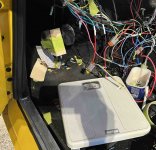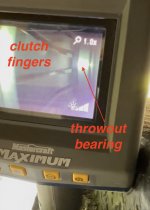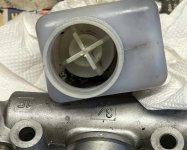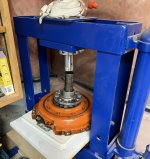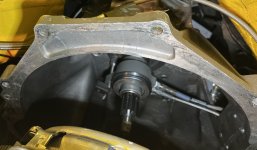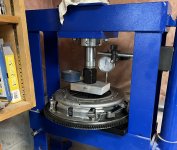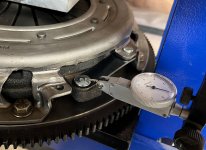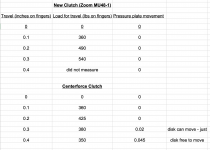- Messages
- 440
While waiting on some parts started working on setting up the Jerico 4 Speed. I had partially set the linkage up but now time to lock it down. Also in installing the RAM Hydraulic Throwout Bearing.
The Jerico is similar to a Toploader but bigger in most respects. My car was modified to support this larger gearbox.
At the time no one made a Hydraulic TB for this combination of Ford, Jerico with it's 1 1/8" x26 spline input shaft size, but I found the RAM Chevy 78125HD would just about do it, and a well built part. The others that might have fit were not very well made or had a history or issues. About the only one's I would try at this point was Tilton or the RAM. The 78125HD is for a slightly smaller bearing retainer size, so had mine turned down a bit to fit. All good.
Now RAM does make one that would fit in the transmission, but basically the same with a larger hole...
To make the hydraulics reliable you need to set them up properly and use the proper fluids, if not, you are doomed. If you don't like using these in a Tiger I can see why, it's a difficult job to replace. In my case, my trans can come out the bottom with no issues due to the removable X brace. Also if you run headers, getting rid of an external slave that is right next to the exhaust is a good thing.
Setting up requires measuring a few things as outlined in the instructions, and all good to go... except it won't quite work due to the guide pin that holds the bearing in places is way to short for the amount of extension I need to just be .100-.200 off the fingers of the pressure plate. It's not problem shimming, but the pin is too short. An email to RAM and they make a 'extended guide pin' which is about an 1" longer that is trim to fit. Shazaam I didn't have to make something.
Now time to lock down all the shifter parts, safety wire things and add some top secret grease to the Long Nascar style shifter. And the top secret tip from GForce who sells the shifter is to use Anti-size on the rails and moving parts as it stays put. OK, I'll give that a go.
Almost ready to bolt back up and double check all the measurements and clearance.
Keeping it moving!









The Jerico is similar to a Toploader but bigger in most respects. My car was modified to support this larger gearbox.
At the time no one made a Hydraulic TB for this combination of Ford, Jerico with it's 1 1/8" x26 spline input shaft size, but I found the RAM Chevy 78125HD would just about do it, and a well built part. The others that might have fit were not very well made or had a history or issues. About the only one's I would try at this point was Tilton or the RAM. The 78125HD is for a slightly smaller bearing retainer size, so had mine turned down a bit to fit. All good.
Now RAM does make one that would fit in the transmission, but basically the same with a larger hole...
To make the hydraulics reliable you need to set them up properly and use the proper fluids, if not, you are doomed. If you don't like using these in a Tiger I can see why, it's a difficult job to replace. In my case, my trans can come out the bottom with no issues due to the removable X brace. Also if you run headers, getting rid of an external slave that is right next to the exhaust is a good thing.
Setting up requires measuring a few things as outlined in the instructions, and all good to go... except it won't quite work due to the guide pin that holds the bearing in places is way to short for the amount of extension I need to just be .100-.200 off the fingers of the pressure plate. It's not problem shimming, but the pin is too short. An email to RAM and they make a 'extended guide pin' which is about an 1" longer that is trim to fit. Shazaam I didn't have to make something.
Now time to lock down all the shifter parts, safety wire things and add some top secret grease to the Long Nascar style shifter. And the top secret tip from GForce who sells the shifter is to use Anti-size on the rails and moving parts as it stays put. OK, I'll give that a go.
Almost ready to bolt back up and double check all the measurements and clearance.
Keeping it moving!

